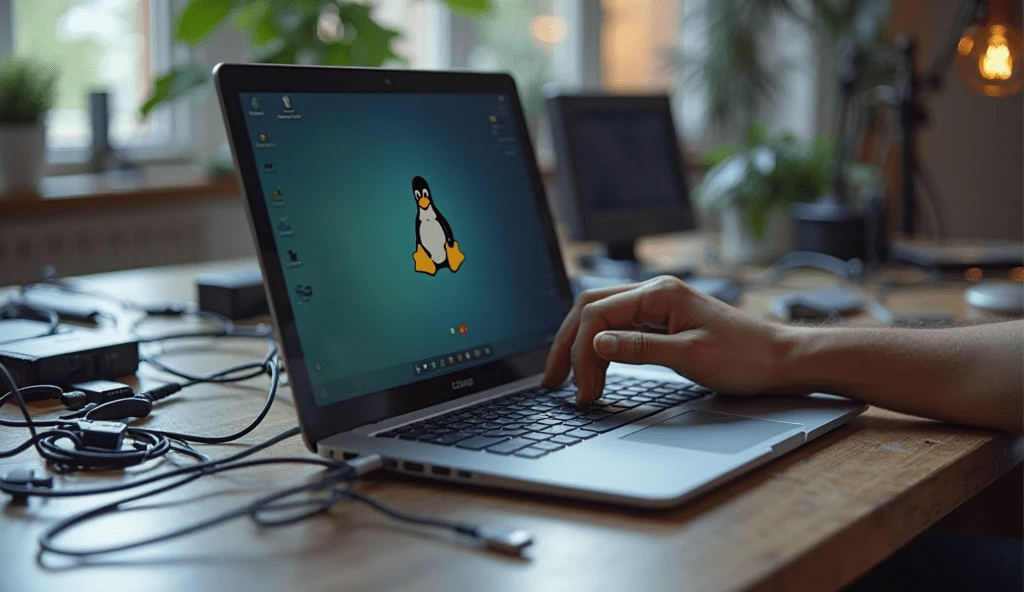Don’t toss it away; use Linux to give it a new life. Even if you’re not very good with computers, this guide will show you how to install Linux on an outdated laptop. Your computer can run faster, smoother, and more safely with lightweight Linux distros like Lubuntu, Linux Mint, or Puppy Linux.
Also, Linux is free, open-source, and may be changed to fit your needs. This instruction is the first step to bringing an old PC back to life with Linux, whether you’re using it to study, browse the web, or code. Let’s give your hardware a fresh lease on life in a simple and effective way.
1. Why put Linux on an old laptop?
Linux operates faster and uses fewer resources than Windows. It is also safer, doesn’t have any extra software, and lets you control your machine completely.
2. Make sure your laptop is compatible
Check your RAM, processor, and disk space before you start. For most Linux distros to work well, they need at least 2GB of RAM and 20GB of storage.
3. Pick the Best Lightweight Linux Distro
Some good choices for old computers are:
- Linux Mint XFCE
- Lubuntu
- Lite version of Zorin OS
- Puppy Linux
- AntiX
These are quick, easy to install, and good for beginners.
4. Make a copy of your data
Put your crucial files on an external disk or in the cloud. If you opt to format the hard drive, Linux installation will destroy everything.
5. Make a USB drive that can boot
You can make a bootable USB drive with software like Rufus or BalenaEtcher. You require a USB disk with at least 4GB of space and the ISO file for the distribution you choose.
6. Get to the BIOS or UEFI settings
To get into BIOS/UEFI, restart your laptop and hit F2, F10, or DEL. Make your USB drive the first thing to boot up.
7. Start up from USB and try Linux Live Mode
Put the USB in, restart the computer, and choose “Try Linux Without Installing.” This lets you check out the features and performance without changing your existing OS.
8. Begin the installation of Linux
On the desktop, click the “Install” button. Follow the steps to set the language, keyboard layout, time zone, and partition settings.
9. Select the type of installation
You can:
- Delete the whole drive and install Linux
- Install next to Windows (dual boot)
- For sophisticated users, use custom partitioning
10. Create a username and password
Make a user account, a password, and a name for your computer. Keep this login information for later.
11. Let the Installer Do Its Thing
Linux is currently going to install. Depending on your machine and the speed of your USB, this could take 10 to 30 minutes.
12. Restart and take out the USB drive.
After you install it, restart your laptop and take out the USB. Your main operating system should now be Linux.
13. Get updates and drivers
After Linux starts up, connect to the internet and get the latest system updates. Most drivers, such those for Wi-Fi, audio, and graphics, will be installed on their own.
14. Set up basic software
Some popular programs are:
- The Firefox or Chromium browser
- LibreOffice for writing
- VLC for media
- GIMP is a program for modifying images
You can get all of these from the Software Center.
15. Make your desktop experience unique
You can modify the icons, themes, backgrounds, and layouts of the panels. You may change Linux to fit your style quite well.
Last Thoughts
Putting Linux on an old laptop is like giving it a new life. It’s quick, safe, and free. Linux works well even on old hardware, whether you’re using it to surf the web or do light work.
Frequently Asked Questions
Q1: Is Linux useful for an aging laptop?
Yes, Linux is great for aging computers because it doesn’t consume as many resources as Windows and is faster and lighter.
Q2: How do you install the Linux operating system step by step?
Get a Linux ISO, make a USB drive that can be used to boot your laptop, and then follow the instructions on the screen to install it.
Q3: Which Linux is best for an old laptop?
Lubuntu, Linux Mint XFCE, and Puppy Linux are all terrific lightweight choices for older computers.
Q4: Can Linux bring antique PCs back to life?
Of course! With new capabilities, Linux can make old, slow computers work like new again.
Q5: How do you install Linux on an old laptop?
If you back up your files and install a lightweight Linux distro, your old laptop will become a fast, safe Linux machine.
Related Posts You’ll Love
Best Items to Sell on Shopify in 2025 (With Low Competition)
How to Use Google Trends to Find Shopify Winning Products
How AI Technology in Daily Life Is Changing Everything in 2025
Best Free VPNs for 2025 – Safe, Fast & No Hidden Costs
The 7 Best Online Tools for Protecting Your Identity Right Now
How to Keep Your Digital Life Safe: Protecting Your Online Identity for Everyone
Easy Ways to Speed Up Windows 11 Instantly (No Tech Skills Needed)

